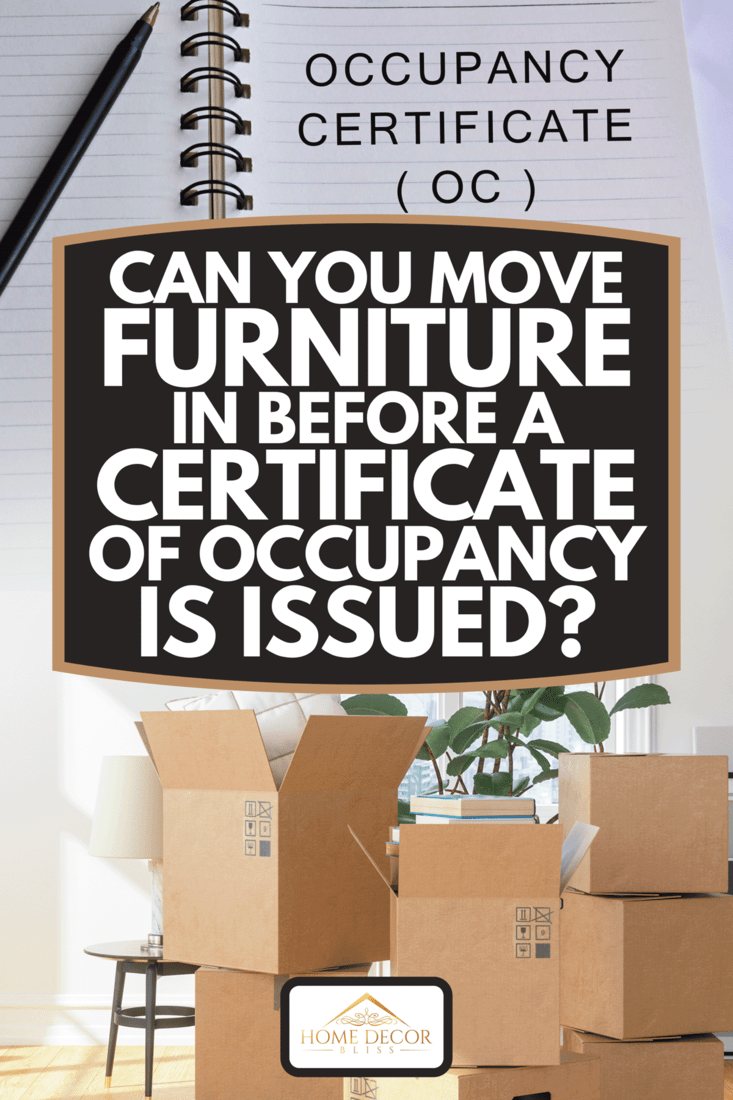Constructing a new home? It seems like construction projects never run on schedule. Perhaps you're in a situation where the project is almost finished, and you're thinking of moving some of your belongings into already finished parts of the house. Since the house is still technically under construction, you might be wondering if it's okay to do so. We researched building codes and municipal ordinances so that you'll know whether or not it's legal to move furniture into a house that doesn't have a certificate of occupancy.
You should never move personal possessions, including furniture, into a building before a certificate of occupancy is issued. Doing so will subject you to potential serious fines and penalties from the local government and might delay the final issuance of your COA.
Now that we know a certificate of occupancy should be issued prior to moving possessions into a building, we'll examine what exactly a COA means. You might also be wondering who issues this certificate or if you're able to sell a house that doesn't have a COA issued to it. To see what we've discovered, read ahead in this post.

What is a certificate of occupancy?
What exactly is a certificate of occupancy, anyway? And why is having one so important? The certificate of occupancy is a legal document that states the building complies with local building codes. By complying with these codes, this COA states that the building is safe to inhabit (residential COA) or conduct business out of (commercial COA).
If you're having a home constructed, you might hear about temporary COAs or provisional COAs. COAs of these types won't refer to your ability to move into the home; rather, these indicate that the building is nearly ready, save for a few minor issues the contractor(s) should resolve. Applying for and receiving one of these COAs means that you are eligible to receive the final installment of a construction loan. You still cannot legally move in until the final COA is issued.
We sometimes add affiliate links and content that was curated and created by our team with the help of advanced ai tools to help showcase the best design styles.

Does The Certificate Of Occupancy Apply To Property Rental Or Ownership?
Who needs a certificate of occupancy and how long it is good for will depend upon your local laws. Generally, a COA needs to be issued after a home is completed, signaling that it is safe to move into and occupy. Many municipalities require that a new COA be issued as soon as a building is sold. Before a new owner can move in, the building must then pass inspections by local inspectors.
What about rental properties? Does this mean that every time a new tenant is preparing to move in, the property must pass inspection? This will also depend on your local laws.
Some areas will require a new COA every time a property is vacated, even if it's a rental unit. Others have rental properties on a set inspection schedule, meaning that the properties only need a new COA issued after a set number of years.

Before moving, it's always a good idea to check with your local building codes.
Who Issues An Occupancy Certificate?
If you live in an area that requires a certificate of occupancy, how do you get one? And who will issue it? Most municipalities that require a COA have full-time inspectors on staff. When you apply for the COA, an inspector will schedule a time to visit the property and begin their routine inspection. What they are looking for will vary from place to place, but there are uniform standards the buildings must meet to ensure compliance. Some of these items include:
- Is there any lead paint present?
- Are there holes in the roof or floor?
- Does the property have working toilets and sinks?
- Is there a functioning water heater?
- Does the HVAC function correctly?
- Are there any visible signs of mold?
As soon as the inspector has finished, the property will either immediately pass or fail. If it passes, the COA should be quickly issued. If it fails, the inspector will notify you of what needs to be corrected before a COA can be given to you. Some items that can cause a property to fail can be immediately remedied, while others might take some time.

Can You Sell A House Without An Occupancy Certificate?
In most cases, you should be able to sell a house without a government-issued certificate of occupancy. The COA is only needed to move yourself and your possessions into the space. The COA has nothing to do with the sale or possession of the property itself.
Depending upon where you live, COAs might only be issued after the home is constructed. This means that the initial residential COA is the only one that will ever be granted; it is transferable upon the sale or rental of the property to another party. However, as we pointed out earlier in this post, local laws vary from place to place. While COAs wouldn't be needed to sell the property, your local government may require one before someone else occupies it.
Knowing the local laws before you move is crucial and could save you a lot of time and hassle. Contacting the city or county government in your community will be very helpful, as they will guide you through the laws in your area.
What Happens If You Live In A House Without A Certificate Of Occupancy?
Maybe you are tempted to go ahead and move into the house before the certificate of occupancy is issued. What's the worst that could happen?
COAs are issued so that people are living in safe structures. Moving into one that has not passed inspection could mean that you are placing your and your family's health in jeopardy. While inspections seem like a hassle, they are put into place so you aren't harmed by carbon monoxide, lead, or other toxins. Inspections also show that the building has proper sanitation and heat, which are critical to healthy living.

Aside from potential health and safety risks, you will also be subjecting yourself to municipal penalties. Depending upon your local laws, the municipal government could fine you every day you illegally occupy the structure. Some local governments even have jail as a penalty.
Unpaid fines can result in being sued by your city or county. This can lead to garnishments on your wages and/or bank accounts. In many places, a lien is placed on property owned by a person that owes money to the local government. This means that the property cannot be sold or transferred until the lien is paid off.
For many good reasons, you should always wait until the inspector issues an occupancy certificate prior to moving in.

In Closing
The purpose of a certificate of occupancy is to prove that the property is a safe structure to inhabit. If you live in an area that requires one, having this COA issued before moving into the property will save you a lot of time, as well as money from potential fines. Be sure you are fully aware of local laws before deciding to move into a new property or rent out your old one.
If you found this post to be informative, we believe you'll enjoy reading the following:
